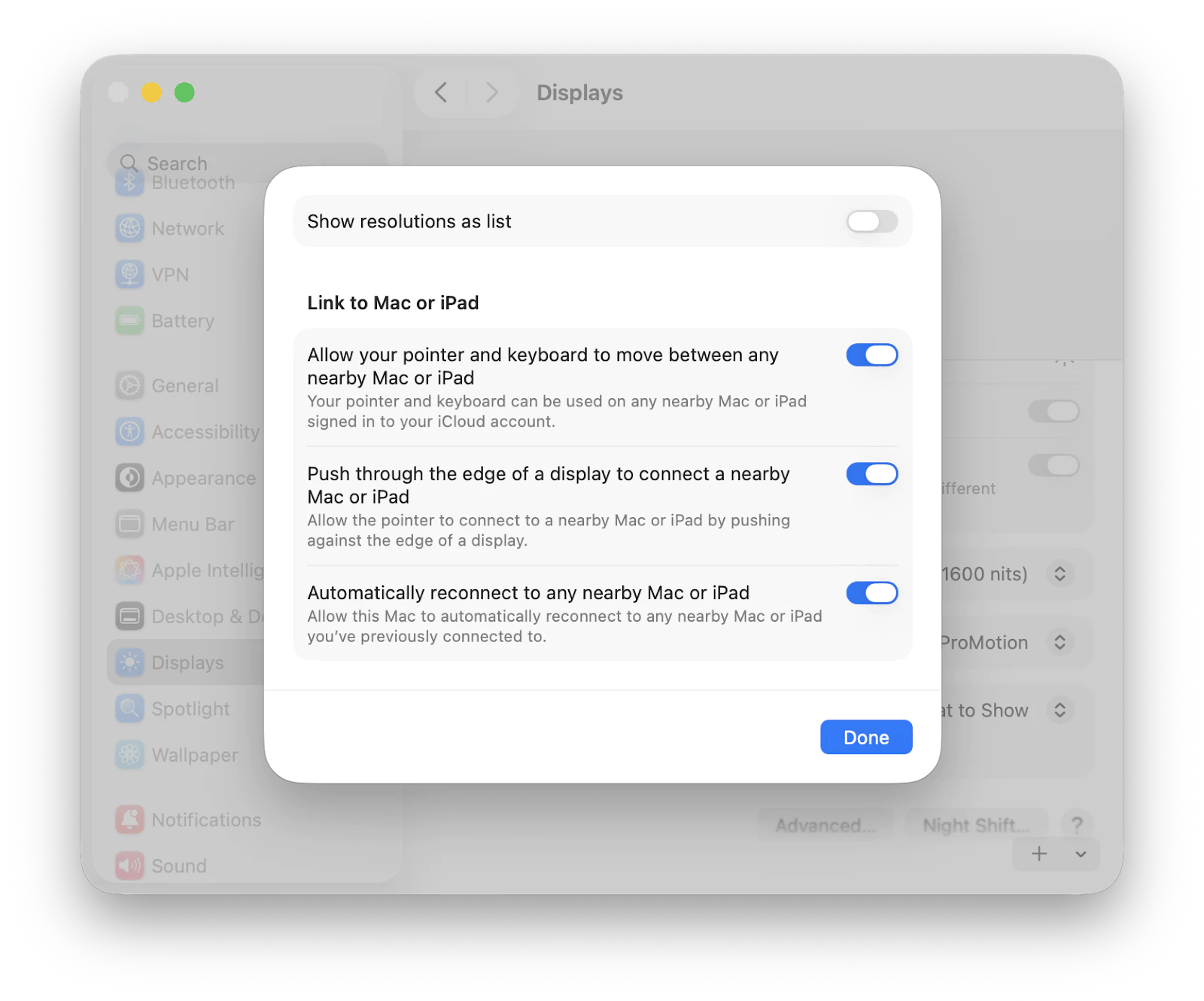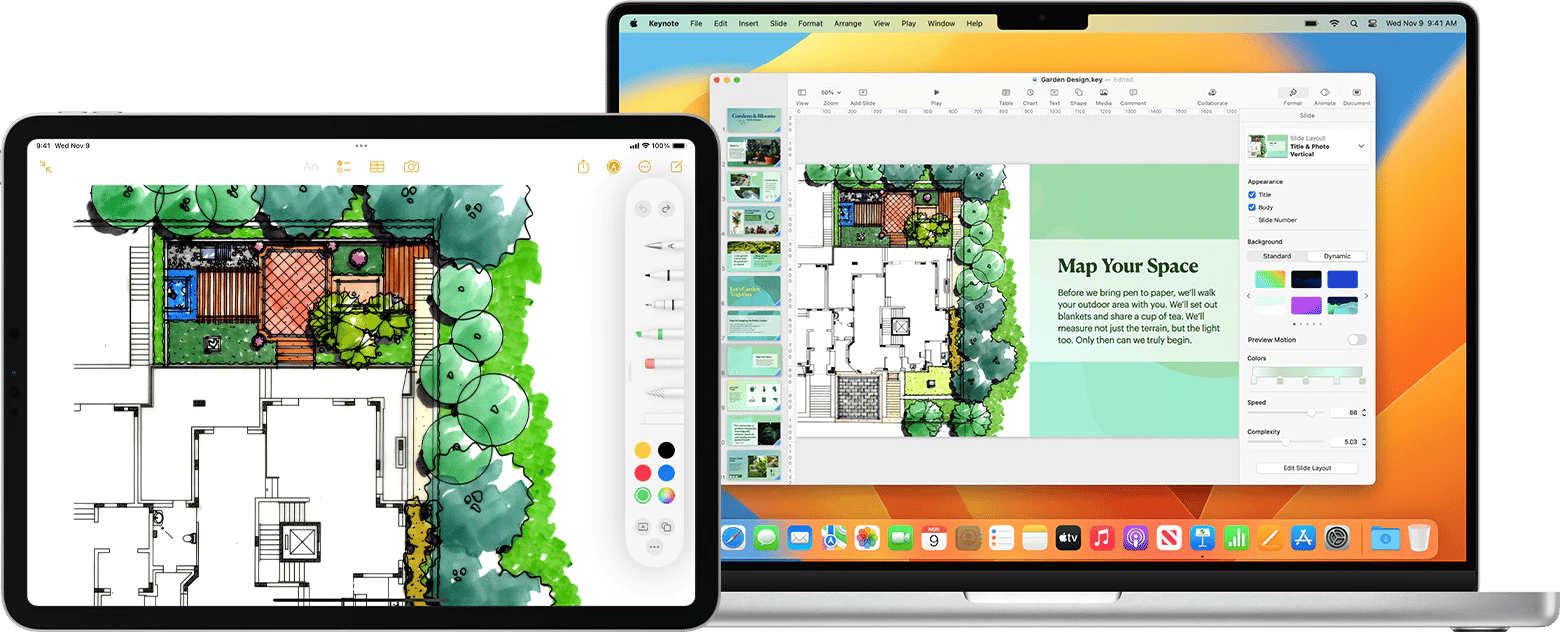How to use Universal Control on your Mac and iPad: Guide for everyone
- Control devices with one keyboard and mouse.
Universal Control lets you control up to three Macs and iPads simultaneously, moving your cursor, typing, and dragging files across devices effortlessly. - Drag and drop files faster than AirDrop.
You can move files, images, text, and screenshots between Mac and iPad by simply moving your cursor across screens. Apps like Yoink or CleanShot X can make managing multiple items easier. - Expand your workspace across devices.
Use your iPad and Mac together as an extended desktop to organize apps, research, or notes, creating a less cluttered and more productive workflow. - Customizable setup for your workflow.
Combine Universal Control with Sidecar, Transloader, or BetterTouchTool to enhance file sharing, remote downloads, and window management across devices. - Easy setup with system requirements.
Make sure your Mac runs macOS Monterey 12.4+ and your iPad iPadOS 15.4+, with the same Apple Account, Wi-Fi, Bluetooth, and Handoff enabled. Once configured, devices automatically connect whenever nearby. - Enhance your workflow with Setapp apps.
Tools like Yoink, CleanShot X, Transloader, and BetterTouchTool are available on Setapp to make Universal Control even more powerful. Get a seven-day free trial.
I've been waiting for Universal Control since Apple announced it in 2021. Using the same mouse and keyboard across multiple devices has saved me time and space, and I can’t imagine going back.
So, I’ll show you how to use Universal Control, plus some handy tips I’ve discovered.
How to turn on Universal Control
First, sign in to the same Apple Account on all devices and make sure to turn on Wi-Fi and Bluetooth. Then:
- On Mac: Go to System Settings > Displays > Advanced. Turn on Allow your pointer and keyboard to move between any nearby Mac or iPad.

- On iPad: Go to Settings > General > AirPlay & Continuity. Turn on Handoff.
- Place your iPad next to your Mac, then push your pointer to the edge of the screen and across to the other device.
Fair warning, though: it took me a few weeks to really get the hang of it and make it part of my routine.
How to drag files between devices
With Universal Control, you can drag and drop files between your Mac and iPad simply by moving your cursor to the edge of one screen until it appears on the other, then dragging the file across — a much faster alternative to AirDrop or waiting for iCloud to sync. This native workflow has saved me countless minutes when moving photos, documents, or screenshots between devices.
And because you’ll likely be dragging and dropping more than before, tools like Yoink can help you temporarily store multiple items before placing them where you need them.

And CleanShot X makes it easy to capture high-quality screenshots or recordings on your Mac and instantly drag them over to your iPad without exporting or uploading.

How to add more screen space
Universal Control expands your screen space by allowing you to use your Mac and iPad displays simultaneously as a single, extended workspace.
To add more space, you can organize your apps across both devices, such as viewing research or notes on the iPad while working on your primary task on the Mac. This setup creates a less cluttered environment and enhances your focus.
How to set Universal Control as the default
To set Universal Control as the default, just enable all three options:
Go to System Settings > Displays > Advanced.
Turn on:
Allow your pointer and keyboard to move between any nearby Mac or iPad.
Push through the edge of a display to connect a nearby Mac or iPad.
Automatically reconnect to any nearby Mac or iPad.

Once these are on, your devices link up on their own whenever they’re nearby and unlocked. In my setup, everything just connects instantly, and all my devices work together without me having to adjust anything.
Read also:
How to customize Universal Control settings
Now, let me share some ways I've customized Universal Control to work better for my setup.
Combine Universal Control with Sidecar. This could be useful if you use more than two devices at the same time. For example, you can connect an iPad to a Mac via Sidecar if you need to expand your Mac screen, but also keep another iPad as an extra workspace for certain types of tasks on the side. It will be easy to control it with your peripherals if you have Universal Control enabled.
Read more about how to use Apple Sidecar.
Tools to improve multiple device control
If you feel like Universal Control doesn’t cover all your needs, enhance it with Transloader. This simple app lets you initiate remote downloads on a Mac from an iPad or an iPhone. For example, if you find a Mac app you like on your iPad, you can just drop it on your Mac with Transloader.
Same with links. You can send links from an iPad to a Mac and have them open automatically.

What are the system requirements for Universal Control?
Most modern Macs and iPads from the last few years are fully compatible, so as long as your devices are reasonably up to date, Universal Control should work smoothly out of the box.
Here are the Universal Control system requirements:
Operating Systems:
macOS Monterey 12.4 or later
iPadOS 15.4 or later
Compatible Mac Models:
MacBook Pro (2016 or later)
MacBook Air (2018 or later)
MacBook (2016 or later)
Mac mini (2018 or later)
iMac (2017 or later, including Retina 5K 27-inch Late 2015 model)
iMac Pro (all models)
Mac Pro (2019 or later)
Mac Studio (all models)
Compatible iPad Models:
iPad Pro (all models)
iPad Air (3rd generation or later)
iPad (6th generation or later)
iPad mini (5th generation or later)
General Requirements:
All devices must be signed into the same Apple ID with two-factor authentication enabled
Bluetooth, Wi-Fi, and Handoff must be enabled on all devices
Devices must be within approximately 10 meters (30 feet) of each other
Devices should not share their cellular or internet connection (i.e., Personal Hotspot or VPN turned off)
Some Universal Control settings may be unavailable if the device or its OS version lacks support
Tip: For the full device information check, use the free MacBook serial number lookup and iPad serial number lookup tools.
What is Universal Control?
Universal Control lets you use one keyboard, mouse, or trackpad to control up to three nearby Macs and iPads at once. It’s designed to make transitioning between devices seamless, so you can drag files, copy text, and manage everything from a single setup.
Why would you want to use Universal Control?
People tend to switch between devices and tasks more often these days. About 85% of consumers report using connected devices while working, according to PYMNTS. So the easier it is to move around, the better.

Source: support.apple.com
Unlike Sidecar, Universal Control keeps your workspaces separate. There’s no screen mirroring, and your device's desktops will show their own files and apps. You’ll just be able to control each of those workspaces more efficiently.
Now you know how to set up Universal Control
That’s how to turn on Universal Control on your Mac. Make sure your Mac is running macOS Monterey or later, and your iPad is running iPadOS 15.4 or later. Once set, your devices will seamlessly work together with the same keyboard, mouse, or trackpad.
Apps like Transloader, Yoink, BetterTouchTool, and CleanShot X can help you enhance Universal Control by adding valuable capabilities. All four, and 250+ more, are available through Setapp, an app platform for macOS and iOS. Don’t have an account yet? Sign up and get a 7-day free trial to explore the apps for free.
FAQ
Which Macs and iPads are compatible with Universal Control?
Universal Control works on Macs with macOS Monterey 12.4 or later (MacBook Pro 2016+, MacBook Air 2018+, iMac 2017+, Mac mini 2018+, Mac Pro 2019+, Mac Studio) and iPads with iPadOS 15.4 or later (iPad Pro, iPad Air 3+, iPad 6+, iPad mini 5+). All devices must use the same Apple Account with two-factor authentication enabled, have Bluetooth, Wi-Fi, and Handoff turned on, and be within roughly 10 meters of each other.
Can I use Universal Control with more than two devices at once?
Yes. Universal Control supports up to three devices simultaneously, including Macs and iPads. You can move your cursor, drag files, and type across each device seamlessly. For complex setups, combining it with Sidecar or external displays allows more flexible workspaces, but each device must meet compatibility requirements and be nearby.
Do I need Wi-Fi or Bluetooth for Universal Control to work?
Universal Control requires Wi-Fi, Bluetooth, and Handoff enabled on all devices. They must be signed into the same Apple Account and within ~10 meters of each other. Personal Hotspot, VPNs, or different networks can interfere, so make sure all devices are on the same network or have network features turned off for smooth operation.
Can I drag and drop files between a Mac and an iPad using Universal Control?
You can drag and drop files, images, text, and screenshots between Mac and iPad by moving the cursor across screens. This is faster than AirDrop or iCloud syncing. Tools like Yoink or CleanShot X (available on Setapp) make managing multiple files or high-quality screenshots even easier.
Why isn’t Universal Control working on my devices?
Common issues of Universal Control not working include:
- Unsupported macOS or iPadOS versions
- Devices not signed into the same Apple Account
- Wi-Fi/Bluetooth/Handoff turned off
- Devices are too far apart, or network conflicts like VPN or Personal Hotspot






